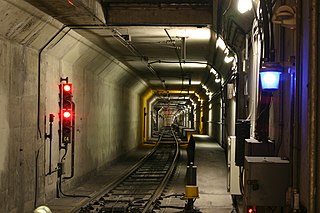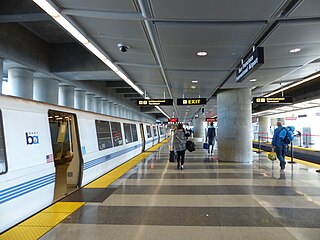Related Research Articles

In cryptography, an HMAC is a specific type of message authentication code (MAC) involving a cryptographic hash function and a secret cryptographic key. As with any MAC, it may be used to simultaneously verify both the data integrity and authenticity of a message. An HMAC is a type of keyed hash function that can also be used in a key derivation scheme or a key stretching scheme.

Bay Area Rapid Transit (BART) is a rapid transit system serving the San Francisco Bay Area in California. BART serves 50 stations along six routes and 131 miles of track, including eBART, a 9-mile (14 km) spur line running to Antioch, and Oakland Airport Connector, a 3-mile (4.8 km) automated guideway transit line serving San Francisco Bay Oakland International Airport. With an average of 169,800 weekday passenger trips as of the third quarter of 2024 and 48,119,400 annual passenger trips in 2023, BART is the sixth-busiest rapid transit system in the United States.

Bartholomew Jojo "Bart" Simpson is a fictional character from the American animated television series The Simpsons who is part of the Simpson family. Bart made his television debut in the short "Good Night" on The Tracey Ullman Show on April 19, 1987. Cartoonist Matt Groening created and designed Bart while waiting in the lobby of James L. Brooks's office. Initially called to pitch a series of shorts based on his comic strip Life in Hell, Groening instead developed a new set of characters. Unlike the other Simpson family members, who were named after Groening's relatives, Bart's name is an anagram of brat. After two years on The Tracey Ullman Show, the Simpson family received their own series, which premiered on Fox on December 17, 1989. Bart has appeared in every episode of The Simpsons except "Four Great Women and a Manicure".

The Transbay Tube is an underwater rail tunnel that carries Bay Area Rapid Transit's four transbay lines under San Francisco Bay between the cities of San Francisco and Oakland in California. The tube is 3.6 miles (5.8 km) long, and attaches to twin bored tunnels. The section of rail between the nearest stations totals 6 miles (10 km) in length. The tube has a maximum depth of 135 feet (41 m) below sea level.

Embarcadero station is a combined BART and Muni Metro rapid transit subway station in the Market Street subway in downtown San Francisco. Located under Market Street between Drumm Street and Beale Street near The Embarcadero, it serves the Financial District neighborhood and surrounding areas. The three-level station has a large fare mezzanine level, with separate platform levels for Muni Metro and BART below. Embarcadero station opened in May 1976 – almost two years after service began through the Transbay Tube – as an infill station.

Montgomery Street station is a combined BART and Muni Metro rapid transit subway station in the Market Street subway in downtown San Francisco. Located under Market Street between Montgomery Street and Sansome Street, it serves the Financial District neighborhood and surrounding areas. The three-level station has a large fare mezzanine level, with separate platform levels for Muni Metro and BART below. Montgomery Street and Embarcadero station to the north are typically the two busiest stations in the BART system.

Powell Street station is a combined BART and Muni Metro rapid transit station in the Market Street subway in downtown San Francisco. Located under Market Street between 4th Street and 5th Street, it serves the Financial District neighborhood and surrounding areas. The three-level station has a large fare mezzanine level, with separate platform levels for Muni Metro and BART below. The station is served by the BART Red, Yellow, Green, and Blue lines, and the Muni Metro J Church, K Ingleside, L Taraval, M Ocean View, N Judah, and S Shuttle lines.

Civic Center/UN Plaza station is a combined BART and Muni Metro rapid transit station in the Market Street subway in downtown San Francisco. Located under Market Street between 7th Street and 8th Street, it is named for the Civic Center neighborhood and the adjacent United Nations Plaza. The three-level station has a large fare mezzanine level, with separate platform levels for Muni Metro and BART below.

The Market Street subway is a two-level subway tunnel that carries Muni Metro and BART trains under Market Street in San Francisco, California. It runs under the length of Market Street between Embarcadero station and Castro station. The upper level is used by Muni Metro lines and the lower level is used by BART lines. BART does not run through the whole subway; it turns south and runs under Mission Street southwest of Civic Center/UN Plaza station. The northeastern end of the BART level is connected to the Transbay Tube. On the Muni Metro level, the southwestern end of the Market Street subway connects to the much-older Twin Peaks Tunnel, and the northeastern end connects to surface tracks along the Embarcadero.

Balboa Park station is a Bay Area Rapid Transit (BART) station and Muni Metro complex in the Mission Terrace neighborhood of San Francisco, California, located near the eponymous Balboa Park. It is an intermodal hub served by four BART routes, three Muni Metro lines, and a number of Muni bus routes. The station complex also includes two rail yards, Cameron Beach Yard and Green Light Rail Center, where Muni maintains Muni Metro trains and heritage streetcars. BART uses a below-grade island platform on the west side of the complex; Muni Metro routes use several smaller side platforms located on surface-level rail loops around the yards.

The Richelieu class were fast battleships built for the French Navy between the 1930s and 1950s. Initially two ships were ordered in 1935 in response to Italian orders for the Littorio-class battleships the previous year. The Richelieus were based on the preceding Dunkerque class, but scaled up to accommodate more powerful 380 mm (15 in) guns and armor to protect them from guns of the same caliber. To keep the ships within the displacement limits imposed by the Washington Naval Treaty, they featured the same concentrated arrangement as the Dunkerques for the main battery: two quadruple gun turrets placed forward. They also incorporated new, more compact boilers that allowed for a shorter hull for the desired top speed. After Germany ordered two Bismarck-class battleships, France responded with another pair of Richelieus, to be built to modified designs. The first, Clemenceau, would have received modified secondary and anti-aircraft batteries, while Gascogne would have had had her superfiring main battery turret shifted aft, along with other changes. Clemenceau was never completed, and Gascogne was never laid down. The Richelieus were the last battleships built for the French Navy.

Maria Geertruida "Ria" Stalman is a Dutch retired discus thrower and shot putter.

For the parent molecule 9,10-anthraquinone, see anthraquinone

San Francisco International Airport station is a Bay Area Rapid Transit (BART) terminal station located adjacent to Garage G inside the San Francisco International Airport. The elevated station is a transfer point to the AirTrain people mover system at Garage G/BART station.
Hemoglobin Barts, abbreviated Hb Barts, is an abnormal type of hemoglobin that consists of four gamma globins. It is moderately insoluble, and therefore accumulates in the red blood cells. Hb Barts has an extremely high affinity for oxygen, so it cannot release oxygen to the tissue. Therefore, this makes it an inefficient oxygen carrier. As an embryo develops, it begins to produce alpha-globins at weeks 5–6 of development. When both of the HBA1 and HBA2 genes which code for alpha globins becomes dysfunctional, the affected fetuses will have difficulty in synthesizing a functional hemoglobin. As a result, gamma chains will accumulate and form four gamma globins. These gamma globins bind to form hemoglobin Barts. It is produced in the disease alpha-thalassemia and in the most severe of cases, it is the only form of hemoglobin in circulation. In this situation, a fetus will develop hydrops fetalis and normally die before or shortly after birth, unless intrauterine blood transfusion is performed.

Electrogenic sodium bicarbonate cotransporter 1, sodium bicarbonate cotransporter is a membrane transport protein that in humans is encoded by the SLC4A4 gene.

Polycomb protein EED is a protein that in humans is encoded by the EED gene.

Protein phosphatase 1 regulatory subunit 7 is an enzyme that in humans is encoded by the PPP1R7 gene.

Milpitas station, also known as Milpitas Transit Center, is an intermodal transit station located near the intersection of East Capitol Avenue and Montague Expressway in Milpitas, California, United States. The station is served by the Orange and Green lines of Bay Area Rapid Transit (BART), the Orange Line of the VTA light rail system, VTA buses, and AC Transit buses.

The Jean Bart class comprised two protected cruisers of the French Navy built in the late 1880s and early 1890s; the two ships were Jean Bart and Isly. They were ordered as part of a fleet program that accorded with the theories of the Jeune École, which proposed a fleet based on cruisers and torpedo boats to defend France. The Jean Bart-class cruisers were intended to serve a long-range commerce raiders to attack enemy merchant shipping. The ships were armed with a main battery of four 164 mm (6.5 in) guns supported by six 138 mm (5.4 in) guns and they had a top speed of 19 to 19.5 knots.